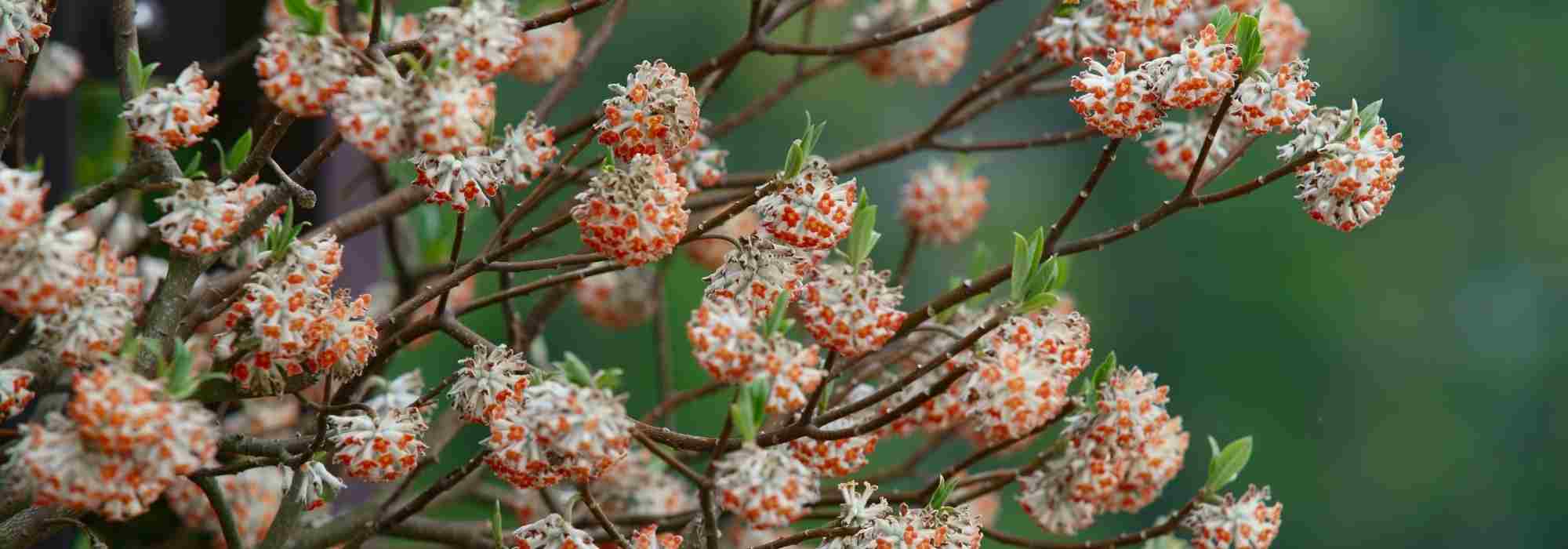
Winter-flowering bushes
The most beautiful winter-flowering bushes
Contents
At the meeting point of the coldest months of the year, some bushes display their flowering in the heart of winter, as if to ward off the gloom and falling temperatures. They bless us with white, yellow, or pink flowers, always graceful and bright, blending well with winter-flowering perennials.
Camellias, Daphnes, Mahonias, Chimonanthus, and many other bushes bring colour and brighten up the rather dark evergreen foliage at this time of year. Many have highly fragrant flowers, which adds to their appeal. Let’s discover these winter-flowering bushes that delight gardens and “winter gardens” from December to March!
Mahonia
Perhaps one of the most well-known and earliest winter-flowering bushes! Mahonias have regained their status in recent years, and they are now particularly highlighted for their great graphic and ornamental qualities.
These bushes are interesting for their long, bright yellow flowering, either in trailing or upright spikes depending on the cultivars. Flowering begins in December with hybrids such as Mahonia x media ‘Charity’, Mahonia japonica, or Mahonia lomariifolia. Their very large, evergreen, leathery, odd-pinnate leaves are another major attraction of this bush, which reaches a height of 2 to 4 m at maturity. Plant in a sufficiently sunny location to see it bloom well. All are melliferous and particularly robust, requiring little care, and they tolerate drought well once established, although they are slow to grow.
N.B.: Mahonia aquifolium flowers later in late winter, remains smaller, and is much less sculptural.
→ Gwenaëlle’s advice: Use the graphic quality of Mahonia in an exotic or contemporary garden, keeping in mind their thorny leaves (not too close to a pathway).
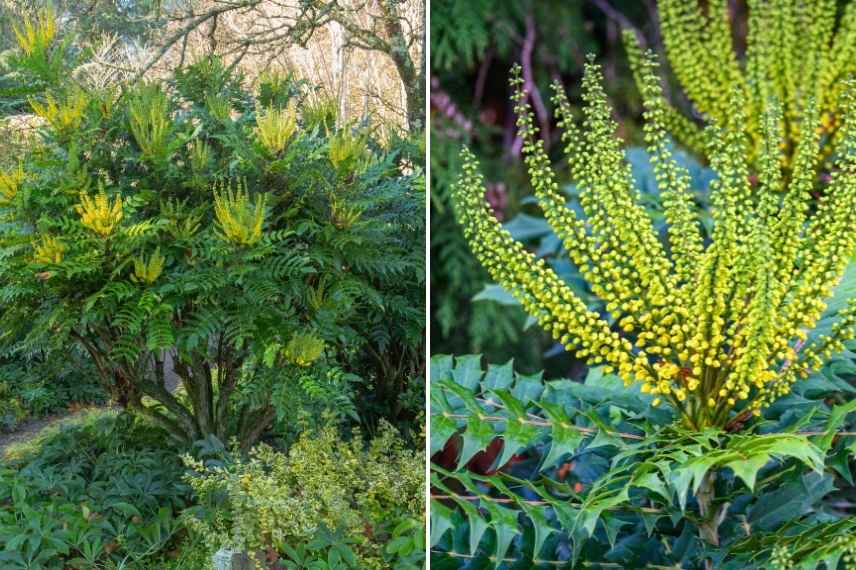
Mahonia x media
Edgeworthia chrysantha
A love of bush, with such graceful poetry: here is the paper tree or Edgeworthia chrysantha, a beautiful bush with yellow to orange flowering depending on the varieties. It is a small-sized bush, about 1.5 m tall, that blooms in February or March. The flowers are gathered in spherical, trailing clusters, like delicately coloured pom-poms, a true beauty! They are particularly noticeable as the bush has not yet developed its leaves. During the other months of the year, Edgeworthia remains ornamental, with a lovely rounded habit, fine foliage, and beautiful branches, even highlighted in winter after the leaves have fallen. It should be planted in partial shade or full sun in slightly acidic soil.
→ Gwenaëlle’s advice: it is charming in a Japanese-style garden, but truly fits in anywhere, in a shrub border, alongside ericaceous plants to welcome the first beautiful days!
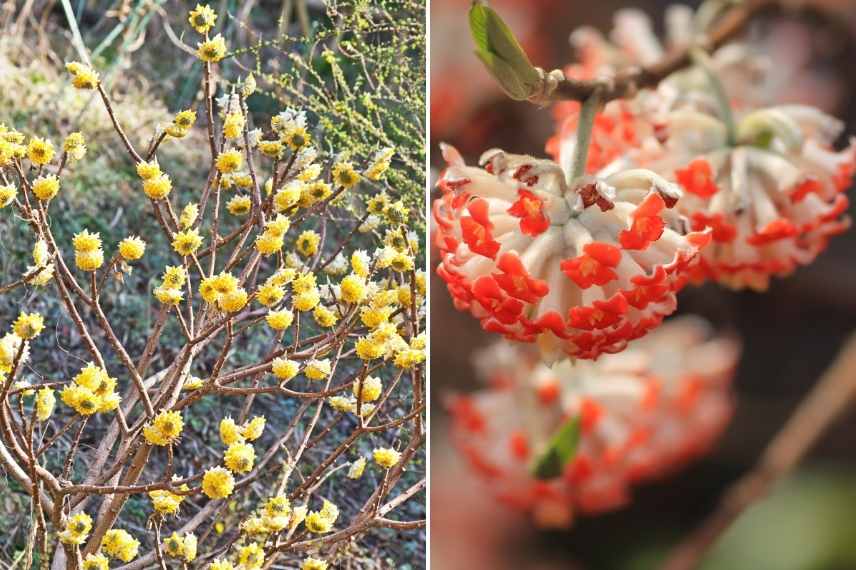
Edgeworthia chrysantha, type species, and on the right the cultivar ‘Red Dragon’
Discover other Winter-flowering shrubs
View all →Available in 0 sizes
Available in 1 sizes
Available in 1 sizes
Available in 1 sizes
Available in 1 sizes
Available in 1 sizes
Available in 2 sizes
Available in 1 sizes
Available in 1 sizes
Available in 1 sizes
Viburnum bodnantense
Here is one of the most stunning winter flowering pink bushes! The Bodnant viburnum or winter viburnum is notable for its bright pink flowers clustered in small bouquets at the tips of the shoots. Flowering occurs on the naked wood, between December and March. They are highly fragrant, including varieties such as ‘Charles Lamont’ and ‘Dawn’. This bush grows upright, reaching 3 m in height, or even more for a narrower spread. Viburnum bodnantense thrives in all soils, is vigorous, and is one of the most frost-resistant shrubs. It should be planted in full sun or partial shade, either as a standalone, in a border, or in a free-standing hedge.
→ Gwenaëlle’s advice: This shrub looks magnificent alongside a Japanese quince, which will take over, or may even flower at the same time in some regions.
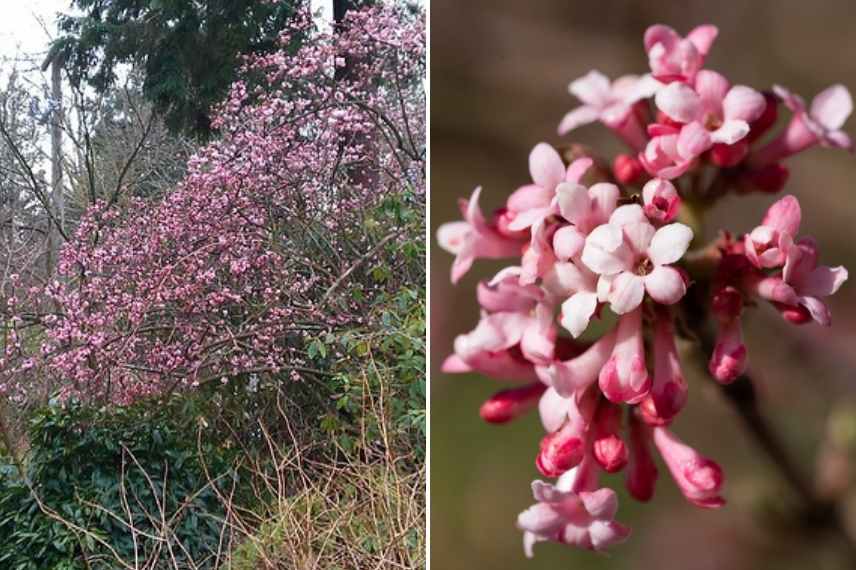
Viburnum bodnantense (© Wendy Cutler)
Corylopsis pauciflora
Not yet widely found in gardens, the Corylopsis pauciflora, or Japanese Hazel, is a wonderful bush to brighten up winter gardens. With a stout and very spreading habit, this small deciduous bush (under 2 m tall with a spread of between 1.80 m and 3 m) blooms quite late, around March, but it is a joy to see it covered in small pale yellow flowers grouped in pendulous racemes (clusters)! The fresh butter colour is enhanced by golden yellow stamens. These small yellow lanterns are delicately scented. The silhouette of Corylopsis pauciflora is also interesting due to its multiple, very spreading branching, with some branches taking on a very horizontal form. In spring, oval and pointed leaves, finely dentate and resembling those of the hazel, appear, turning yellow in autumn. The Japanese Hazel requires a sunny location and prefers slightly acidic, cool soil. It has a relatively slow growth rate.
→ Gwenaëlle’s advice: The Corylopsis pauciflora makes a good companion for Hamamelis, or alongside a Stachyurus praecox, which resembles it with its equally poetic flowering, but with trailing pearls, slightly taller and displaying beautiful autumnal leaf colours.

Corylopsis pauciflora
Witch hazels
Witch Hazels are among the stars of winter, with their unusual, frayed flowering on the still naked branches. These shrubs bring astonishing colours to the garden in mid-winter: yellow flowering in Hamamelis mollis, ’Pallida’ and ‘Arnold Promise’, orange in ‘Jelena’ and ‘Aphrodite’, pink in ‘Ruby Glow’ and ‘Rubin’, red in ‘Diane’ and ‘Fox Lady’, and purple in ‘Washington Park’… A true festival of warm colours unfolds in the garden from December for the earliest varieties, but especially in January and February. These are small bushes, measuring 2 to 3 m in height with a spread often greater, as their habit is upright in youth, becoming more spreading with age. All Hamamelis are hardy and require sunlight to display their abundant flowering, along with acidic, well-drained, and cool soil.
→ Gwenaëlle’s advice: Witch Hazels suffer during dry periods, so they should be avoided in the south of France and reserved for gardens that maintain good soil moisture. Stunning when planted alone or in groups!

Hamamelis ‘Feuerbauzer’ top left, Hamamelis mollis top right, and below autumn foliage and flowering of ‘Diane’ (© Sylvia Sassen)
Heathers
Considered as undershrubs rather than bushes, we include them in this selection for their essential winter interest. There are several heathers that bloom in the heart of winter: the Ericas carnea (snow heather) of alpine origin, and Ericas x darleyensis (winter heather), a hybrid of Erica carnea and Erica erigena. Both have numerous varieties with bell-shaped white, pink, or mauve flowers, are ultra hardy, evergreen, bloom for at least 2 consecutive months, tolerate some lime although they prefer very well-drained, acidic, even poor soils, and can be planted in full sun or bright partial shade.
→ Gwenaëlle’s advice: Prefer Erica x darleyensis by the sea, as it is less sensitive to winds and salt spray.
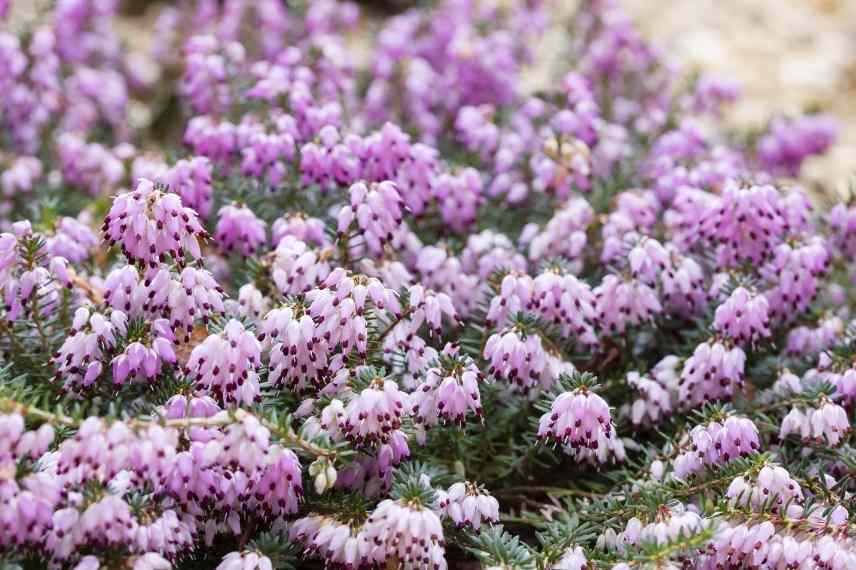
Erica x darleyensis
→ Learn more about heathers in our comprehensive guide: Heathers: planting, pruning, and maintaining
Daphne odora
Among the most fragrant shrubs of winter, Daphne odora reign supreme, but they are not only appreciated for this olfactory quality: they are evergreen shrubs offering one of the longest and most generous winter flowerings, from January to March. They bloom in shades of pink, either light or pronounced, with the flowers gathered in a bouquet emitting a captivating lemony and floral fragrance. Some Daphne odora have more or less marginate foliage, such as ‘Aureomarginata’, finely edged in cream, or ‘Mariani’, more broadly. They all form a bushy and rounded shrub (maximum 1.50 m at maturity). Renowned for their slow growth and short lifespan (about ten years), they are excellent shrubs for shaded and semi-shaded gardens, as they dislike the sun. Provide them with acidic, cool, humus-bearing, and well-drained soil for optimal growth.
→ Gwenaëlle’s advice: Plant Daphne odora along a frequently used path or at the entrance of the house to enjoy its heady fragrance, in a small garden or in a pot on a terrace. Choose their location carefully, as they do not appreciate being moved.

Daphne odora Aureomarginata and Daphne Marianni
Chimonanthus praecox
Decidedly too little known, the Chimonanthus praecox is a remarkable bush with winter flowering. It is endlessly charming with its yellow petal flowers and purple stamens contrasting at the base of the tepals. The very shape of the flowers is delightful, being small, waxy, pendulous bells that emerge on the naked wood, which exude a delicious scent of honey and spices. The early Chimonanthus reaches about 2.5 m in height with a spread of 2 m, and has deciduous foliage that turns yellow in autumn. Plant it in full sun or partial shade in cool, well-drained soil.
→ Gwenaëlle’s advice: Although hardy, the Chimonanthus praecox requires a sheltered position from cold winds to flower well. It is very beautiful when planted alone or in a shrub border, or at the back of a border.
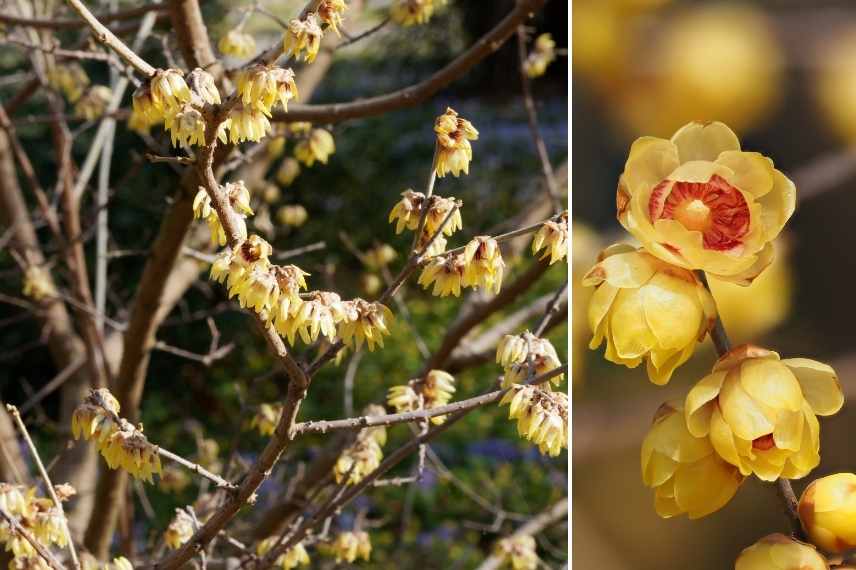
Chimonanthus praecox
Camellias
The Japanese Camellias are a genus with numerous varieties and hybrids and feature some of the largest flowers among winter bloomers. They come in a wide range of colours, white, pink, red, variegated, with single or double, imbricate or peony-like flowers… and appear between December and April, depending on the cultivars and regions. With dark, glossy, evergreen foliage, these bushes are considered heather soil plants, to be planted in soil that is strictly acidic and humus-bearing. They are sensitive to frost and especially to snow. These are shade-loving shrubs, with northern and eastern exposures being most favourable. Some wild Camellias offer a less rigid silhouette than classic Camellias.
→ Gwenaëlle’s advice: The rooting of camellias is deep, so be sure to consider their location well in advance. Choose your camellia in bloom to avoid any colour disappointments.

Camellias offer a great diversity of colours and forms
→ Learn more about Camellias in our comprehensive guide.
Sarcococcas
This strange name encompasses a genus of small evergreen bushes that are very useful in shady gardens, illuminating them with the whiteness of their flowering. The Sarcococcas bloom between January and March, in the axil of the leaves, all along the branches, sometimes upright, sometimes very flexible, depending on the varieties. They are particularly fragrant, sometimes tinged with pink in certain varieties. The flowers will develop into black, fleshy berries. Related to the boxwood, the Sarcococcas have beautiful, tough, glossy, oblong leaves. Depending on the varieties, they range in height from 0.50 m to 1.50 m.
→ Gwenaëlle’s advice: this is a perfect shrub for dry shade, ideal for planting in shaded borders or under deciduous trees, as it does not fear root competition.
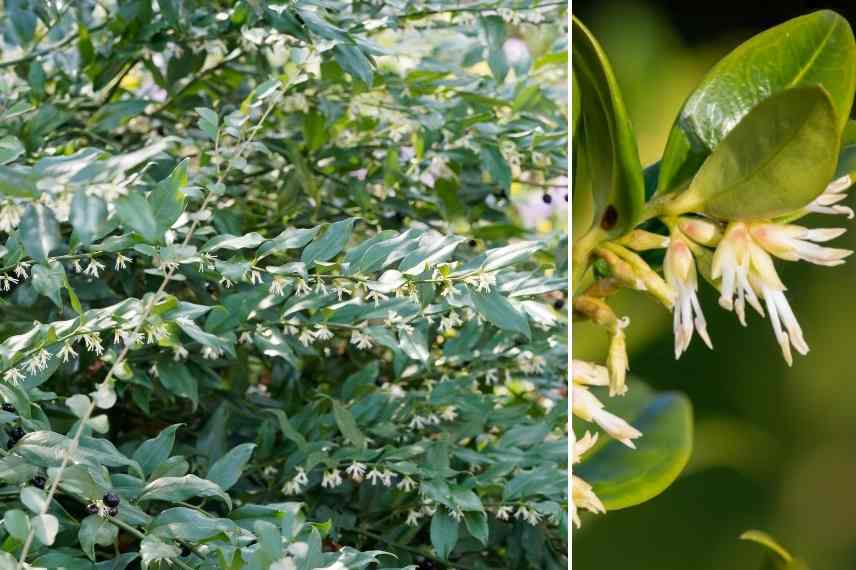
Sarcococca confusa
Lonicera fragrantissima
Another fragrant bush, but this one may just take the crown with the Daphnes as its scents can be detected from several metres away! It must be said that the Lonicera fragrantissima is not an ordinary honeysuckle: flowering in the middle of winter, from January to February, it has a bushy habit, particularly ramified, arched, and spreading. It is adorned with a myriad of small whitish to yellow flowers starting in January and continuing into February. It creates a fragrant cloud that graces the garden…
→ Gwenaëlle’s advice: with its very diffuse habit, the Lonicera fragrantissima takes its space… it thrives in a country garden.

Lonicera fragrantissima
Could you please provide the text you would like me to translate?
The Salix caprea and its cultivars with their soft aments, the Viburnum tinus (laurel tin), the Japanese quinces sometimes starting their flowering as early as January in regions with mild winters, the Garrya elliptica with its long, almost ghostly pendulous aments, the Cornus mas with its bright yellow flowers…, the early Mimosas (Acacias dealbata)… Discover also our selection of: 6 shrubs for early winter flowering.
All you have to do is choose which of these graceful shrubs will awaken your dormant garden!
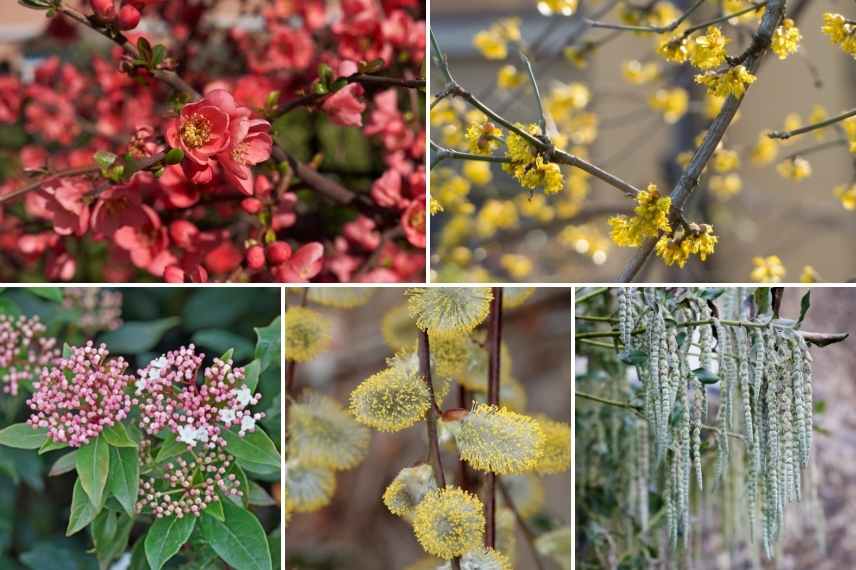
Japanese quince, Cornus mas, Viburnum tinus, Salix caprea ‘Kilmarnock’ and Garrya elliptica
For further reading
Discover Olivier’s tips for a beautiful garden even in winter:
- Subscribe!
- Contents
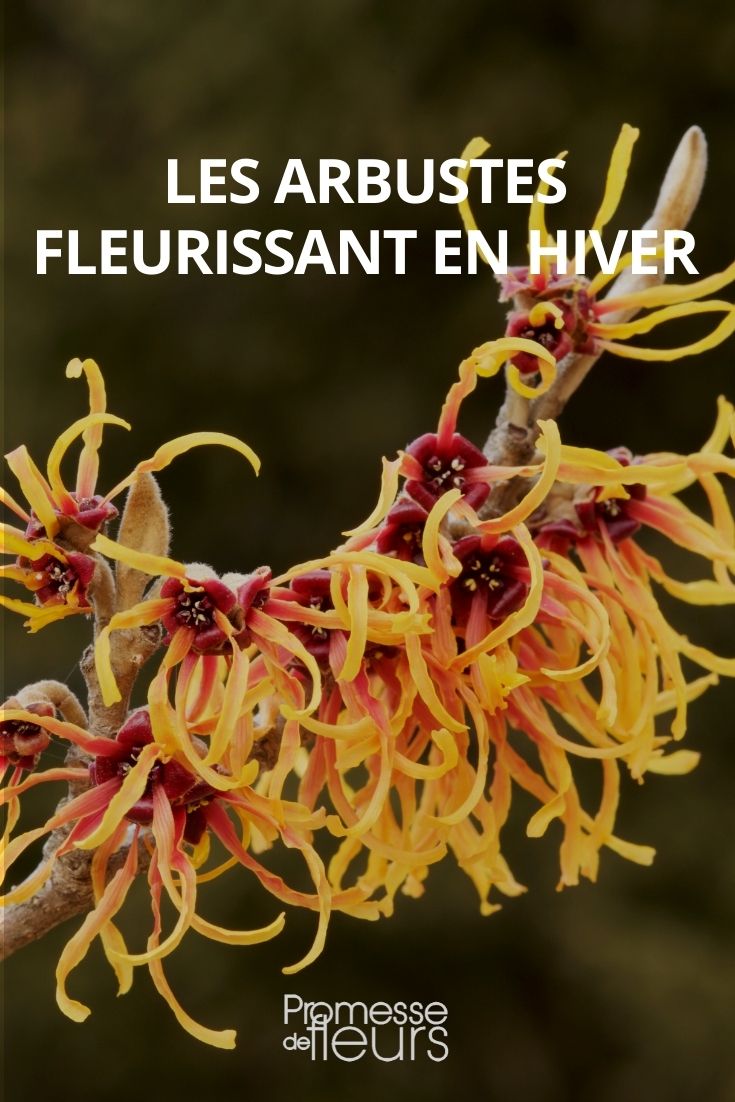


































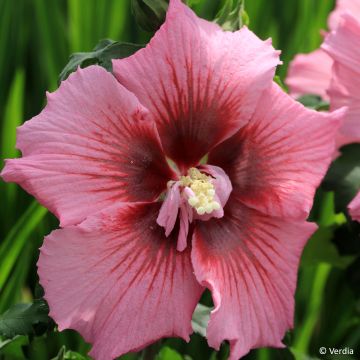
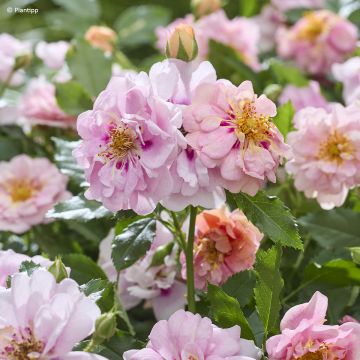
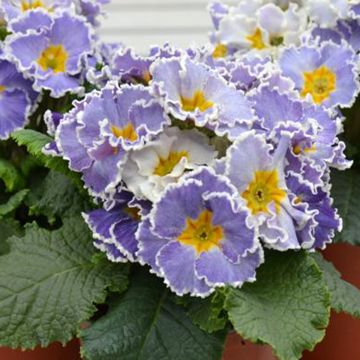
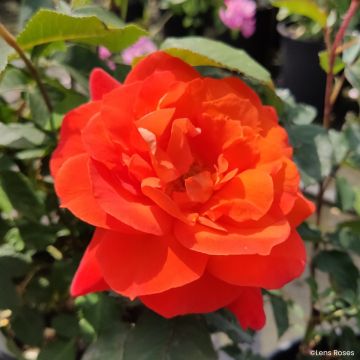
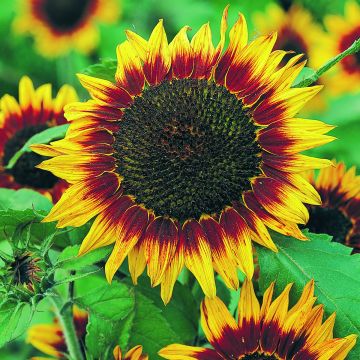
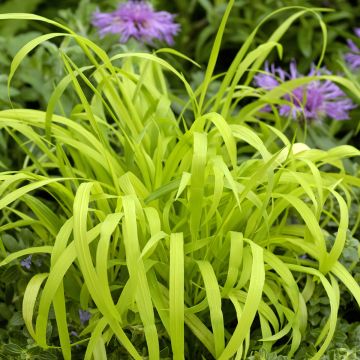
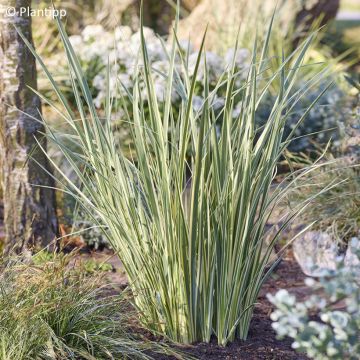
Comments